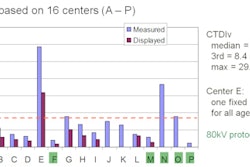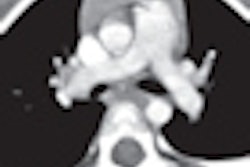A new analysis of a major cardiac risk study published today in the Journal of the American Medical Association found that CT coronary artery calcium scoring (CACS) significantly boosts the power of traditional risk factors for predicting adverse cardiac events over the long term.
The study results show that adding CT calcium scores enables risk assessment to be refined across the board. Patients newly identified to be at high risk of coronary heart disease (CHD) can thus be referred for more comprehensive preventive therapies to reduce their risk of a heart attack.
"When CACS is added to traditional risk factors, it results in a significant improvement in the classification of risk for the prediction of CHD events in an asymptomatic population," wrote Dr. Tamar Polonsky from Northwestern University in Chicago and colleagues from several other U.S. institutions (JAMA, April 28, 2010, Vol. 303:16, pp. 1610-1616).
Improving traditional risk factors
The study aimed to determine whether adding calcium scores to a prediction model based on traditional risk factors improves risk classification. The researchers incorporated results from a final cohort of 5,878 of the 6,814 participants in the Multi-Ethnic Study of Atherosclerosis (MESA), a population-based cohort without known cardiovascular disease. Participants were followed for a median of 5.8 years by telephone interview and other methods to monitor cardiac events and mortality. Patients with diabetes were excluded because the condition itself represents a risk factor for cardiovascular events.
The researchers created five-year risk estimates for incident coronary heart disease, divided into three categories -- 0% to less than 3%, 3% to less than 10%, and 10% or more -- using Cox proportional hazards models.
Model 1 incorporated race/ethnicity and standard Framingham risk factors including age, gender, tobacco use, systolic blood pressure, antihypertensive medication use, and high-density lipoprotein and total cholesterol. Model 2 used the above risk factors plus CAC scoring.
"We calculated the net [risk level] reclassification improvement and compared the distribution of risk using model 2 versus model 1," Polonsky and her colleagues wrote.
There were a total of 209 events during the median 5.8 years of follow-up, including 122 myocardial infarctions, deaths from coronary heart disease, or cases of resuscitated cardiac arrest.
Model 2, which added CAC scoring, delivered significant improvements in risk prediction compared with model 1, demonstrating a net reclassification improvement of 25% (95% confidence interval [CI]: 16%-34%, p < 0.001).
Model 1 classified 69% of the cohort into either the highest or lowest risk categories, compared to 77% with model 2. Importantly, using model 2 reclassified an additional 23% (n = 728) of those who experienced events as high risk -- with an event rate of 8.7% (95% CI: 6.9%-11.1%) over the follow-up period.
An additional 12.7% (n = 744) of participants without cardiac events were reclassified as low risk using model 2, with an event rate of just 2.7% (n = 17, 95% CI: 1.8%-4.1%). Two high-risk individuals who were reclassified as low risk experienced cardiac events (6.3%).
The five-year event rate for the entire cohort was 3.1% (95% CI: 2.7%-3.6%).
The area under the receiver operator characteristics (ROC) curve for the prediction of events was 0.76 (95% CI: 0.72-0.79) using model 1 -- increasing to 0.81 (95% CI: 0.78-0.84, p < 0.001) with CACS, a finding that was consistent with a previous report using the MESA cohort.
Looking at individuals considered intermediate risk in model 1, a total of 292 (16%) were reclassified as high risk, while 712 (39%) were classified as low risk, a 55% net reclassification improvement (95% CI: 41%-69%, p < 0.001).
"The improvement in risk classification is more balanced between events and nonevents for intermediate-risk individuals than the overall cohort (0.29 for events and 0.26 for nonevents)," the authors wrote.
And among the 115 events that were recorded among intermediate-risk participants, 48 (41%) were among individuals reclassified as high risk versus 15 (13%) among individuals reclassified as low risk, the authors noted.
In the overall cohort, the integrated discrimination index (IDI), which measures the improvement in average sensitivity, was 0.026 (p < 0.001) using model 2, an 81% improvement in the discrimination slope.
"Incorporation of an individual's CACS leads to a more refined estimation of future risk of CHD events than traditional risk factors alone," the authors wrote.
Moreover, the classification of intermediate-risk patients was improved more than the cohort overall.
"This study provides strong evidence that there may be a significant amount of clinically useful reclassification when CACS is added to risk assessment in asymptomatic intermediate-risk patients," Polonsky and colleagues wrote.
Costs and risks
There is ongoing debate about the best way to assess at-risk patients, they noted, and some suggest that the costs and risks of coronary calcium scoring are higher than the cost of simply treating everyone at intermediate risk.
"Importantly, almost 60% of the events (123/209) occurred among individuals who were not classified as high risk either by traditional risk factors or CACS," the group wrote. "The smaller number of participants who were classified as high risk is likely in part a reflection of the study population. More than half of the MESA cohort is in the lowest five-year risk category based on traditional risk factors."
The results need to be validated, particularly in a cohort at higher overall risk, which would produce higher event rates and different rates of reclassification, they added. Longer follow-up could also change the results. Also not answered in this study is whether screening for CACS improves patient outcomes.
Finally, because the patients were given their CAC scores, the diagnosis of angina may have been biased, thereby inflating the net reclassification improvement rate.
"We found that use of CACS plus traditional risk factors substantially enhances the ability to classify a multiethnic cohort of asymptomatic persons without known [cardiovascular disease] into clinically accepted categories of risk of future CHD events," Polonsky and colleagues concluded. "The results provide encouragement for moving to the next stage of evaluation to assess the use of CACS on clinical outcomes."
By Eric Barnes
AuntMinnie.com staff writer
April 28, 2010
Related Reading
Coronary CTA best next test for positive stress patients, April 23, 2010
A normal coronary artery calcium score is reliable for several years, March 12, 2010
Does coronary calcification accurately predict occlusion? Experts disagree, February 19, 2010
Zero calcium score enough to send chest pain patients home, February 10, 2010
Symptomatic patients with zero CT calcium scores still have cardiac events, October 2, 2009
Copyright © 2010 AuntMinnie.com



















